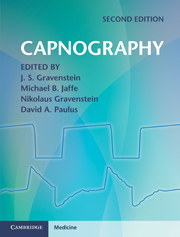Crossref Citations
This Book has been
cited by the following publications. This list is generated based on data provided by Crossref.
Whitaker, D. K.
2011.
Time for capnography - everywhere.
Anaesthesia,
Vol. 66,
Issue. 7,
p.
544.
Schmalisch, G
Al-Gaaf, S
Proquitté, H
and
Roehr, C C
2012.
Effect of endotracheal tube leak on capnographic measurements in a ventilated neonatal lung model.
Physiological Measurement,
Vol. 33,
Issue. 10,
p.
1631.
Hartmann, A.
Strzoda, R.
Schrobenhauser, R.
and
Weigel, R.
2014.
CO2 sensor for mainstream capnography based on TDLAS.
Applied Physics B,
Vol. 116,
Issue. 4,
p.
1023.
Said, Engy T.
2014.
Clinical Anesthesiology.
p.
93.
Block, Frank E.
and
Block, Frank E.
2015.
Decreasing False Alarms by Obtaining the Best Signal and Minimizing Artifact from Physiological Sensors.
Biomedical Instrumentation & Technology,
Vol. 49,
Issue. 6,
p.
423.
Bridgeman, Devon
Tsow, Francis
Xian, Xiaojun
and
Forzani, Erica
2016.
A new differential pressure flow meter for measurement of human breath flow: Simulation and experimental investigation.
AIChE Journal,
Vol. 62,
Issue. 3,
p.
956.
YÜKSEL, Melih
PEKDEMİR, Murat
YILMAZ, Serkan
YAKA, Elif
and
KARTAL, Aslı Gülfer
2016.
Diagnostic accuracy of noninvasive end-tidal carbon dioxide measurement in emergency department patients with suspected pulmonary embolism84-90.
TURKISH JOURNAL OF MEDICAL SCIENCES,
Vol. 46,
Issue. ,
p.
84.
Ganta, Raghuvender
2017.
Data Interpretation in Anesthesia.
p.
39.
Abrosimov, V. N.
Byalovskiy, Yu. Yu.
Subbotin, S. V.
and
Ponomareva, I. B.
2017.
Volumetric capnography: abilities in practical pulmonology.
PULMONOLOGIYA,
Vol. 27,
Issue. 1,
p.
65.
Gutiérrez, Jose Julio
Leturiondo, Mikel
Ruiz de Gauna, Sofía
Ruiz, Jesus María
Leturiondo, Luis Alberto
González-Otero, Digna María
Zive, Dana
Russell, James Knox
Daya, Mohamud
and
Lazzeri, Chiara
2018.
Enhancing ventilation detection during cardiopulmonary resuscitation by filtering chest compression artifact from the capnography waveform.
PLOS ONE,
Vol. 13,
Issue. 8,
p.
e0201565.
Welch, Stephen M.
Nelson, Christopher S.
and
Barnes, Stephen L.
2018.
Surgical Critical Care and Emergency Surgery.
p.
59.
Kobayashi, Naoki
and
Yamamori, Shinji
2018.
Seamless Healthcare Monitoring.
p.
311.
Kellerer, Christina
Jankrift, Neele
Jörres, Rudolf A.
Klütsch, Klaus
Wagenpfeil, Stefan
Linde, Klaus
and
Schneider, Antonius
2019.
Diagnostic accuracy of capnovolumetry for the identification of airway obstruction – results of a diagnostic study in ambulatory care.
Respiratory Research,
Vol. 20,
Issue. 1,
Kitsos, Vasileios
Demosthenous, Andreas
and
Liu, Xiao
2020.
A Smart Dual-Mode Calorimetric Flow Sensor.
IEEE Sensors Journal,
Vol. 20,
Issue. 3,
p.
1499.
Böhm, S. H.
Kremeier, P.
Tusman, G.
Reuter, D. A.
and
Pulletz, S.
2020.
Grundlagen der Volumetrischen Kapnographie.
Der Anaesthesist,
Vol. 69,
Issue. 4,
p.
287.
KAMINOH, Yoshiroh
2020.
Airway Management for a New Age.
THE JOURNAL OF JAPAN SOCIETY FOR CLINICAL ANESTHESIA,
Vol. 40,
Issue. 2,
p.
148.
Baba, Yuya
Takatori, Fumihiko
Inoue, Masayuki
and
Matsubara, Isao
2020.
A Novel Mainstream Capnometer System for Non-invasive Positive Pressure Ventilation.
p.
4446.
Dervieux, Emmanuel
Théron, Michaël
and
Uhring, Wilfried
2021.
Carbon Dioxide Sensing—Biomedical Applications to Human Subjects.
Sensors,
Vol. 22,
Issue. 1,
p.
188.
Derevschikov, Vladimir Sergeevitch
Kazakova, Evgenia Dmitrievna
Yatsenko, Dmitry Anatolievich
and
Veselovskaya, Janna Vyacheslavovna
2021.
Multiscale study of carbon dioxide chemisorption in the plug flow adsorber of the anesthesia machine.
Separation Science and Technology,
Vol. 56,
Issue. 3,
p.
485.
Vijayam, Bhuwaneswaran
Supriyanto, Eko
and
Malarvili, M. B.
2021.
Digitization and Analysis of Capnography Using Image Processing Technique.
Frontiers in Digital Health,
Vol. 3,
Issue. ,





